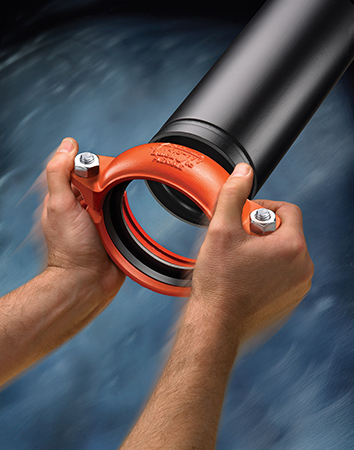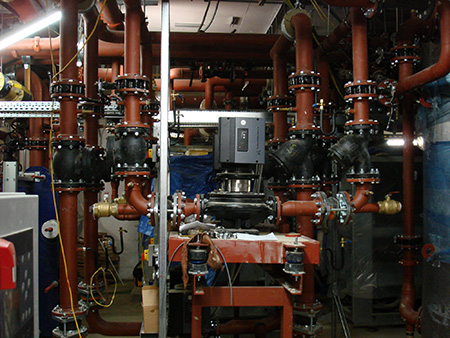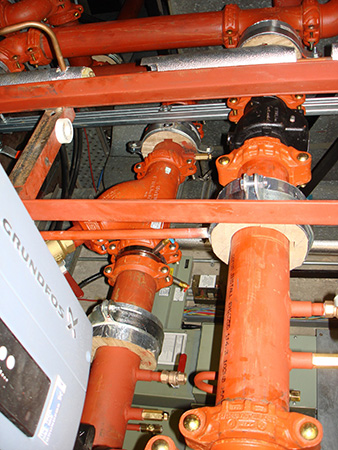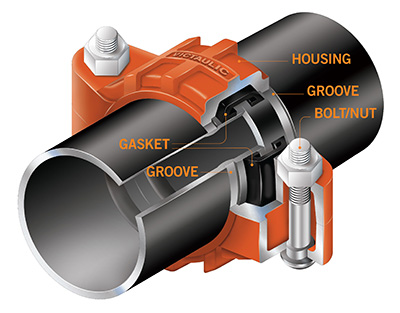We use cookies to deliver you the best experience of LUCKINSlive according to our privacy policy which explains what cookies are and how we use them.
By closing this message, we'll assume that you are happy with our use of cookies on this device.
Many piping systems including building services, water treatment, and plant utility piping systems use flanges in pipe runs to join pipe, and to allow pipe sections to be assembled and disassembled if a piping system has to be modified or maintained in the future.
An effective alternative to flanging is the use of grooved mechanical joints that offer faster installation and disassembly when maintenance is required, as well as other performance and design benefits.
Andy Carter, Victaulic Product Engineer, compares the flanged and grooved pipe-joining methodologies and the advantages they deliver.
Traditional flanging
Flanging is one of the more "traditional" pipe joining methods and has been around for many years. Because of this tradition many piping components – such as pumps, valves and chillers – are supplied with flanged connections. Flanging is commonly used in certain scenarios where speed and a degree of flexibility is required although it is not a system that allows for easy system contraction and expansion.
Depending on the pipe joining system employed, installation and maintenance time will increase reducing system efficiencies. A flanged pipe joint is a good example of this. Flanges are bolted together, compressing a gasket to create a seal. The bolts and nuts of a flanged union and gasket absorb and compensate for system forces and, over time, the bolts and nuts can stretch due to surges, system working pressure, vibration, and expansion and contraction. When these bolts yield, the gasket can "slip" which can result in a leak.
Depending on the location and service of the piping system, subsequent leaks can be costly and hazardous, resulting in downtime and exposure to risk.
Gasket replacement may be required, particularly when the flange is taken apart. Also, over time, the gasket can bond to the flanged pipe ends. When the joint is disassembled, the gasket will need to be scraped off the flanged pipe end and replaced, again increasing downtime due to maintenance. Because of system expansion and contraction flange gaskets can also take on compression over time, resulting in leakage, as well.
Robust and Safe
A solution for these common problems is to use grooved couplings in place of flanges. In fact mechanical connections are becoming more common as they can offer practical as well as economical advantages.
A mechanical joint, or coupling, is comprised of four basic but robust elements: the pipe groove, the gasket, the coupling housings, and the nuts and bolts. A pipe groove is formed by cold forming or machining a groove into the end of a pipe – using a variety of Victaulic grooving tools, it is possible to do this onsite or offsite in a workshop enabling prefabrication.
The coupling gasket is pressure responsive and is encased by the coupling housing when it engages in the groove around the circumference of the pipe. The gasket then creates a seal unified joint that is enhanced when the system is pressurized.
With both rigid and flexible style couplings available, couplings can be used in virtually every application instead of a flange. Rigid grooved mechanical couplings are designed to provide a rigid pipe joint connection, permitting neither linear, angular nor rotational movement at the joints.
Flexible grooved mechanical couplings on the other hand are designed to allow controlled linear and angular movement at each joint that can accommodate pipeline deflection. They offer security whilst also accommodating potential misalignments without the need to install the expensive and delicate specialized equipment that are necessary with flanged or welded systems.
A third benefit can be derived from the use of three flexible couplings used near a source of vibration. Flexible couplings reduce noise and vibration and eliminate the need for specialized noise reduction components.
Flanges, a rigid pipe joining method, are not ideal for environments in which there is pipe movement, such as thermal expansion, vibration or building settlement. Expansion and contraction can stress the flange and piping, which can compromise the gasket over time. When this occurs, the joint is at risk of leaking. Grooved flexible couplings can provide pipe movement in the form of axial movement or angular deflection, and can accommodate thermal pipe movement.
In many ways, mechanical pipe joining can offer a more efficient solution than flanging and is a widely accepted method for joining pipe based on the simple system access they provide and their proven reliability - couplings can match the pressure ratings of flanges with no significant difference in flow dynamics.
Grooved couplings also reduce the weight of a system and only require two bolts to complete a joint, versus eight bolts in a like size flange.
Flexible Install
On initial installation, boltholes of a flange must be precisely aligned, and then tightened to hold the joint. Also the bolt-hole index on equipment inlets and outlets must line up perfectly with the flange on the piping to be connected to the unit. With only one of a number of fixed positions determined by the number of holes in a flange, a fitting or valve can only be rotated to match the bolt holes. All this results in an increased risk of misalignment issues in the field.

Mechanical couplings are not only faster and easier to install than flanges – they are also more flexible and are stronger.
Grooved systems do not have this problem and allow much more convenient installation with a full 360-degree rotation. There is no bolt-hole pattern to line up, and a coupling can be oriented at any angle around the joint. The coupling can be "free floated" around the pipe in the field to provide easy access to the bolts, and in turn, simplify access to the equipment.
In addition to eliminating misalignment issues during installation, a coupling’s 360-degree orientation capabilities coupled with its smaller profile, compared to a flange, makes the installation of grooved systems ideal for confined spaces. Flanges are roughly twice the width of the pipe they are attached to.
On average, grooved couplings are only half this size. The size advantage of the smaller design makes the grooved system ideal for jobs where space is limited – such as mechanical rooms and refurbishment of existing buildings – and any jobs that demand additional flexibility.
Speed of Assembly
Because couplings also have fewer bolts and typically no torque requirements, grooved piping is up to six times faster to install than flanging. Couplings require just two bolts and for larger sizes (over 26"/660mm) just four bolts. For comparison at this higher size range a flange would require a minimum of 20 nuts and bolts.
So for example, to flange a 6"/150mm joint on Schedule 40 Carbon Steel pipe requires eight bolts and would take approximately 1.5 man hours to complete. This could be completed in just 20 minutes using a grooved solution, or around 10 minutes using a Victaulic Installation-Ready coupling, since these do not require disassembly prior to installation. Both grooved solutions require just two nuts and bolts.

Flanged joints in a mechanical room: flanges are roughly twice the width of the pipe they are attached to.
These time savings only increase with larger diameter piping systems. For example, a 36"/900mm flange joint on Standard Wall (3/8"/9.7mm) carbon steel pipe would require 32 nuts and bolts and around 10 man-hours to complete, but only four nuts and bolts and around two hours with a grooved coupling.
In addition, flanges require time consuming star pattern tightening with specialised wrenches to measure and ensure that correct torque ratings are achieved. Grooved technology allows couplings to be assembled by simple hand tools and the joint is properly installed once bolt pads of the coupling housings meet metal-to-metal.
Victaulic grooved systems are designed for visual inspection to ensure complete assembly. When the bolt pads are metal-to-metal this indicates a properly installed coupling. Flanges, on the other hand, do not provide visual confirmation and the only measure to ensure proper assembly is to fill and pressurise the system and check for leaks.
The same characteristic of grooved systems that accelerate installation—fewer bolts and no torque requirements — also makes system maintenance a quick and simple task. When piping needs to be moved, rotated, changed or added, the two or four bolts of a coupling make these maintenance tasks much more efficient than a flange, which can have up to eight times as many bolts.
To gain access to a pump or valve, for example, the two bolts of the coupling are loosened, and the housings and gasket are removed from the joint. In a flanged system, multiple bolts need to be removed. The same time-consuming bolt-tightening sequence required upon initial installation is also required upon reassembly of the flange.

A mechanical coupling has 360-degree orientation capabilities and a low profile - making it ideal for installation in confined spaces
Couplings eliminate a lot of the regular maintenance associated with flanges, decreasing maintenance downtime, because they do not require regular retightening. Unlike a flange that puts variable stress on the gasket and nuts and bolts, a coupling holds the gasket in precise compression from the outside of the pipe joint. Additionally, coupling gaskets do not need to be replaced on a regular maintenance schedule, while flange gaskets need to be replaced when the system is disassembled for maintenance.
Better Vibrations
Over the life of a system, flanging can require quite a bit more work to maintain joint integrity. Pumps and other equipment frequently create vibration and noise in a piping system. For example, oscillatory forces can be generated due to the lack of balance of rotating components such as from pump vanes. Although field balancing can reduce this, it requires specialized equipment, which can become difficult, expensive and impractical.
System vibration and other forces can lead to joint problems in a flanged system. Flanging employs a series of bolts and nuts to compress a gasket between two flat-faced, flanged pipe ends. The torque on the bolts employs a high compressive load on the internal gasket, which can cause the gasket to adhere to one or both of the flanges. When the joint is disassembled, the gasket can tear, resulting in failure upon reinstallation if not replaced.
In order to accommodate system vibration and reduce noise, flanged systems employ specialised and expensive rubber bellows or braided flexible hoses to accommodate this vibration. Over time or due to overextension, these products can wear out or fail, requiring replacement.
Furthermore, the bolts and nuts of a flanged union absorb system forces, and over time, can relax due to surges, system working pressure, vibration, and expansion and contraction. When the bolts lose tension, the gasket can “slip,” which can result in a leak. Flange gaskets can take on compression over time, also resulting in leakage. To prevent or stop leaks, routine bolt and nut tightening is required.

The mechanical grooved joint is comprised of four elements: grooved pipe, gasket, coupling housings, and nuts and bolts.
The ability of grooved couplings to accommodate system vibration reduces the risk of joint issues. Grooved systems can accommodate vibration without the need for speciality products that require periodic repair or replacement. The resilient elastomeric gasket contained within both flexible and rigid couplings aids in dampening noise and vibration.
Recently, acoustical consulting firm SSA Acoustics, in Seattle, Washington, undertook a field measurement that showed three Victaulic couplings, placed in series in a pipe section, have a comparable performance to twin-sphere neoprene connectors and a superior performance to braided metal hoses. Victaulic couplings dampened the overall vibration amplitude by 80% to 90%.
Each successive joint creates a further reduction in vibration. Independent test laboratory Nutech Testing Corporation/SE Laboratories used Victaulic mechanical couplings in its testing, and concluded that, for any given pipe diameter, less vibration is transmitted with each additional Victaulic coupling, regardless of whether Victaulic flexible or rigid couplings are used.
The gasket absorbs the vibrations, not the bolts and nuts. Over the life of the system, the nuts and bolts do not require regular retightening and will not slip or relax, thus maintaining a leak-tight seal. The gasket of a grooved coupling has a C-shaped cross section seal that is very durable and can handle significant compressive and cyclical loading. A system can be pressurized and depressurized repeatedly without fatiguing the rubber. Gaskets from Victaulic are rated for life-of-the-system service.
Conclusions
In summary, grooved piping systems can offer significant advantages over their flanged equivalents because of their speed of installation, maintainability and alignment ease. These characteristics, coupled with additional benefits such as design versatility, safety and reduced total installed costs, are leading many installers, engineers and owners to choose grooved mechanical systems instead of flanges.
About the Author

Andy Carter is Product Engineer at Victaulic, the world leader in mechanical pipe joining systems, and is an affiliate member of the Chartered Institution of Building Services Engineers. He has a degree in mechanical and electrical engineering and 23 years' experience of providing technical support for a range of products.
AGS and Installation-Ready Technology
The Advance Groove System and Installation-Ready technology are amongst the latest innovations in mechanical grooved piping systems introduced by Victaulic, the world leader in mechanical pipe grooving systems.
The Advanced Groove System (AGS) was developed by Victaulic for medium to large diameter pipes between 350mm/14” and 1525mm/60”, and is designed to offer enhanced strength and reliability through a more robust coupling housing and a patented wedge-shaped roll groove that is deeper and wider thus providing increased coupling-to-pipe engagement and higher pressure ratings. The AGS design results in a 40 percent increase in end load carrying capabilities compared to previous joining methods.
The patented Victaulic Installation-Ready technology line makes mechanical pipe joining even more efficient than ever before. Couplings are delivered to the jobsite ready to install, without the requirement to first disassemble prior to installation. In fact, Victaulic installation-ready couplings can be installed up to ten times faster than welding, six times faster than flanging, and twice as fast as standard mechanical grooved couplings.
We use cookies to deliver you the best experience of LUCKINSlive according to our privacy policy which explains what cookies are and how we use them.
By closing this message, we'll assume that you are happy with our use of cookies on this device.

 Search is in progress, please be patient...
Search is in progress, please be patient...

 Searching ALL product data, this can take a while please be patient...
Searching ALL product data, this can take a while please be patient...


